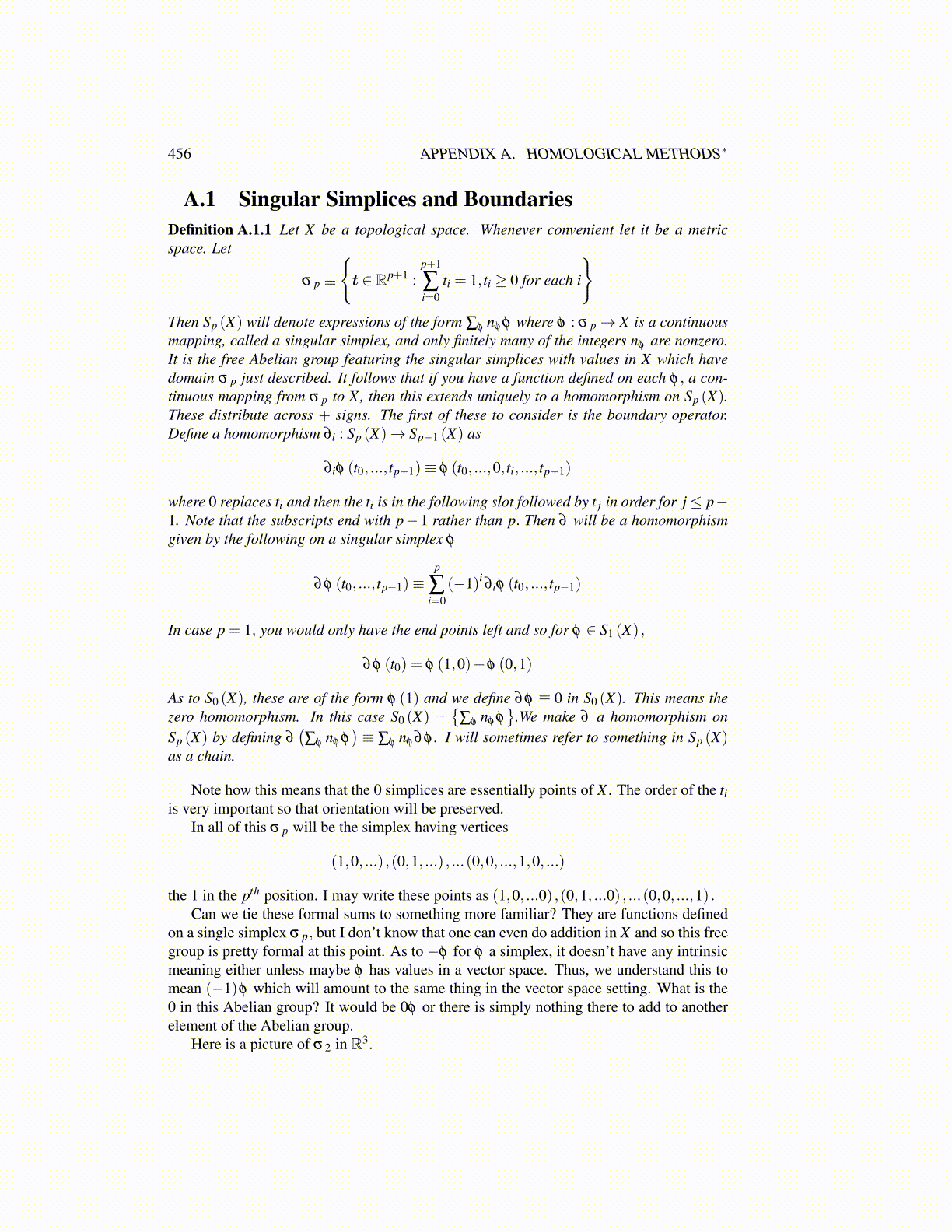
456 APPENDIX A. HOMOLOGICAL METHODS∗
A.1 Singular Simplices and BoundariesDefinition A.1.1 Let X be a topological space. Whenever convenient let it be a metricspace. Let
σ p ≡
{t ∈ Rp+1 :
p+1
∑i=0
ti = 1, ti ≥ 0 for each i
}Then Sp (X) will denote expressions of the form ∑φ nφ φ where φ : σ p→ X is a continuousmapping, called a singular simplex, and only finitely many of the integers nφ are nonzero.It is the free Abelian group featuring the singular simplices with values in X which havedomain σ p just described. It follows that if you have a function defined on each φ , a con-tinuous mapping from σ p to X, then this extends uniquely to a homomorphism on Sp (X).These distribute across + signs. The first of these to consider is the boundary operator.Define a homomorphism ∂i : Sp (X)→ Sp−1 (X) as
∂iφ (t0, ..., tp−1)≡ φ (t0, ...,0, ti, ..., tp−1)
where 0 replaces ti and then the ti is in the following slot followed by t j in order for j≤ p−1. Note that the subscripts end with p−1 rather than p. Then ∂ will be a homomorphismgiven by the following on a singular simplex φ
∂φ (t0, ..., tp−1)≡p
∑i=0
(−1)i∂iφ (t0, ..., tp−1)
In case p = 1, you would only have the end points left and so for φ ∈ S1 (X) ,
∂φ (t0) = φ (1,0)−φ (0,1)
As to S0 (X), these are of the form φ (1) and we define ∂φ ≡ 0 in S0 (X). This means thezero homomorphism. In this case S0 (X) =
{∑φ nφ φ
}.We make ∂ a homomorphism on
Sp (X) by defining ∂(∑φ nφ φ
)≡ ∑φ nφ ∂φ . I will sometimes refer to something in Sp (X)
as a chain.
Note how this means that the 0 simplices are essentially points of X . The order of the tiis very important so that orientation will be preserved.
In all of this σ p will be the simplex having vertices
(1,0, ...) ,(0,1, ...) , ...(0,0, ...,1,0, ...)
the 1 in the pth position. I may write these points as (1,0, ...0) ,(0,1, ...0) , ...(0,0, ...,1) .Can we tie these formal sums to something more familiar? They are functions defined
on a single simplex σ p, but I don’t know that one can even do addition in X and so this freegroup is pretty formal at this point. As to −φ for φ a simplex, it doesn’t have any intrinsicmeaning either unless maybe φ has values in a vector space. Thus, we understand this tomean (−1)φ which will amount to the same thing in the vector space setting. What is the0 in this Abelian group? It would be 0φ or there is simply nothing there to add to anotherelement of the Abelian group.
Here is a picture of σ2 in R3.